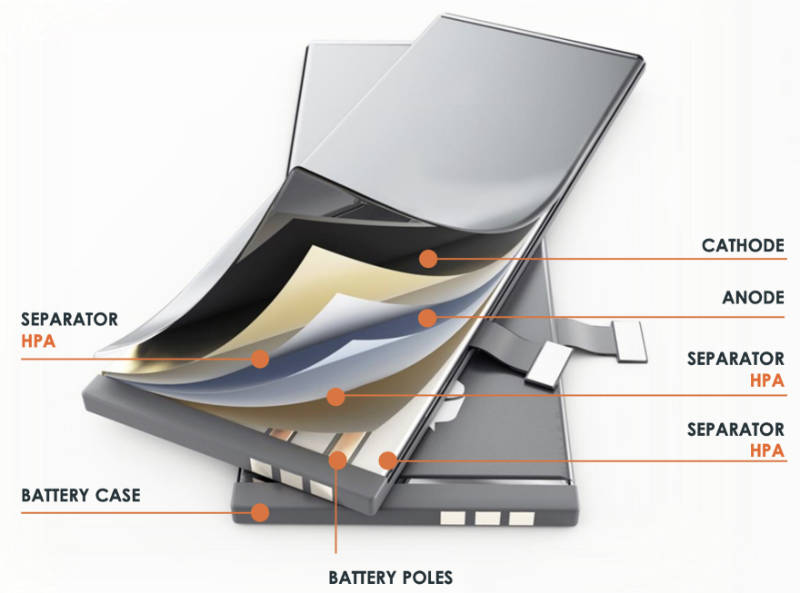Fact – HPA can make batteries safer and better. Also fact – these ASX plays are into it

These are the companies who are pushing the HPA narrative to the forefront. Pic: Brand X Pictures via Getty Images
Materials used in the manufacturing of lithium-ion batteries that are found in electric vehicles or energy storage solutions are hot property on the ASX.
Lithium, nickel, cobalt and even manganese are all sought-after commodities and companies exploring for or producing them have drawn more than their fair share of attention.
But there’s one material, which despite seeing increased used in batteries (and in substantial quantities), is still relatively unknown.
High purity alumina – a very high purity (+99.99%) type of aluminium oxide that is often produced from kaolin feedstock – is a high value critical mineral that is hardly unknown in the industrial sector given its use in creating synthetic sapphire crystals used in LED lights, semiconductors, watch faces and smartphones.
However, it is also seeing greater use to coat the separators that keep the cathodes and anodes in lithium-ion batteries apart, which has been found to significantly improve safety by providing greater thermal stability and reducing the risk of batteries catching fire, as well as significantly improving impedance that allows for high power capability.
It also improves battery life and lowers self-discharge.
With each EV battery using some 5kg – and up to 30kg depending on its size – of HPA, this use of the material has the potential to quickly outstrip demand from other uses.

Indeed, batteries already account for about 20% of current HPA production and it is likely to grow further.
According to Business Research Insight, sales of ceramic (HPA) coated separators totalled about US$1.6bn in 2021 and are forecast to grow at a 25% compound annual growth rate to US$7.8bn by 2028.
This growth is rapid enough that some commentators have indicated that even if every planned HPA project comes online, there will not be enough supply to meet estimated demand over the next decade and beyond.
ASX high purity alumina plays
Given the growing demand for HPA, it is certainly worth taking a look at some of the company’s looking to advance their HPA projects.
Alpha HPA (ASX:A4N)
As its name clearly implies, Alpha is focused on delivering its HPA First Project in Gladstone, Queensland, which seeks to commercialise its proprietary aluminium purification and refining technology.
The potential of this technology was enough for the company to be awarded a $15.5m grant under the Federal Government’s Critical Minerals Development Program.
Alpha has deployed the first tranche $6.82m funding from the CMDP to progress its Stage 1 Precursor Production Facility (PPF) noting in its March 2023 quarterly report that all major equipment orders are now finalised and under construction.
The company noted that once fully deployed, the CMDP funding would have facilitated the capability to produce 10tpa of additional HPA production capacity and the production of HPA tablets for sapphire glass growth.
It is also continuing its product qualification and discussions with potential end users for its range of ultra-high purity aluminium products.
This included the delivery of a larger volume of HPA test samples for the third phase of testwork to an EU based cathode manufacturer along with a modest HPA sales order during its attendance at the Inter Battery Show in Seoul in mid-March.
Alchemy Resources (ASX:ALY)
While Alchemy is focused on its lithium, gold and copper assets, it does hold the advanced West Lynn project in New South Wales’ Lachlan Fold Belt that has a 7Mt alumuina resource.
Positive metallurgical testwork completed in 2019 has managed to produce a 99.95% HPA product, though more work is required to achieve 4N (99.99%) quality.
This resource is located above the nickel-cobalt resource at West Lynn and could be mined concurrently.
ChemX Materials (ASX:CMX)
Advanced materials company ChemX is focused on exploring its Eyre Peninsula projects – including the Kimba kaolin project – and developing its HiPurA HPA processing technology.
Initial test work has indicated that the HiPurA process is low cost and low in energy consumption, compared to alternative tech.
HiPurA also benefits from not being tied to any one mine as its feedstock is a widely available chemical.
A $600,000, 24tpa pilot plant is currently under construction in Perth to producer larger quantities of HPA for customer qualification.
Corella Resources (ASX:CR9)
The company is taking the fast track towards becoming a producer of high purity kaolin that is imminently suitable for processing into HPA.
Its Tampu deposit about 250km northeast of Perth, Western Australia, has a resource of 24.7Mt of bright white kaolinised granite though recent successful drilling has demonstrated that there is potential for major resource growth.
The company has also acquired a grain storage facility just 2.5km away that can be quickly repurposed to support planned mining operations and has secured required critical infrastructure.
What’s especially important for Corella is that the low level of iron impurities at Tampu positions it perfectly as a source of HPA feedstock.
An upgraded resource estimate is currently underway to underpin a Scoping Study that will include options for supply into traditional and HPA markets.
Critical Minerals Group (ASX:CMG)
While Critical Minerals Group is focused on the vanadium resource contained within its Lindfield project in Queensland, the project also hosts an alumina resource of 363Mt at 4.8% Al2O3 that is currently being analysed for its suitability for conversion into HPA.
Should test work prove that HPA feedstock can be extracted via simple flow sheet design alongside the vanadium production, this will add considerable value to the project.
The company has started a Scoping Study for Lindfield that while focused on its vanadium resource, will include the potential for alumina as feedstock for HPA production.
FYI Resources (ASX:FYI)
Despite the shock exit of Alcoa from its advanced HPA project, FYI remains committed to its development using the company’s innovative flowsheet design, which has been demonstrated through multiple pilot plant production runs.
The company’s ability to produce high purity HPA has also been demonstrated with targeted end users reacting positively to the end product.
A Definitive Feasibility Study completed in April 2021 for the 10,000tpa project had outlined after-tax net present value and internal rate of return – both measures of a project’s profitability – of US$1,014m and 55% respectively.
Annual EBITDA is estimated at US$186m over its 25-year mine life while Capex is a handy US$202m.
Impact Minerals (ASX:IPT)
Impact is progressing its Lake Hope project, which contains globally unique high-grade aluminium clay minerals in the top few metres of a playa lake, which has unique physical and chemical properties that allow for low-cost mining and offsite metallurgical processing via a novel and cost-disruptive acid leaching process.
Preliminary economic studies indicate that the production of HPA from Lake Hope will be cost-competitive with current producers and other developers in Australia and globally.
A Pre Feasibility Study is currently underway into the development of Lake Hope while a Mining Lease application will be lodged early in the September quarter.
The company is earning a 80% interest in the project by completing the PFS, funding for which was secured last month after raising $4m through a share placement.
At Stockhead we tell it like it is. While ChemX, Corella Resources and Impact Minerals are Stockhead advertiser, they did not sponsor this article.
Related Topics
UNLOCK INSIGHTS
Discover the untold stories of emerging ASX stocks.
Daily news and expert analysis, it's free to subscribe.
By proceeding, you confirm you understand that we handle personal information in accordance with our Privacy Policy.








